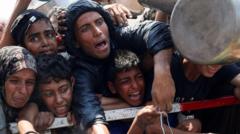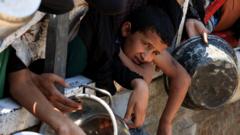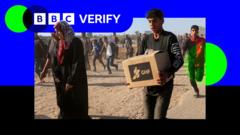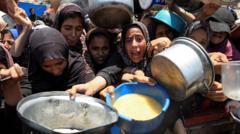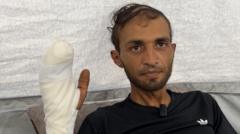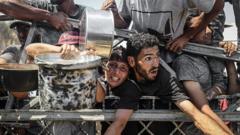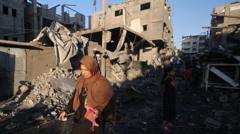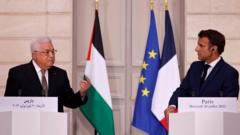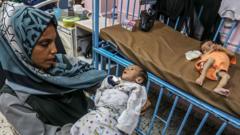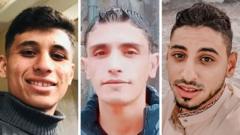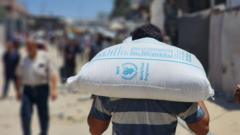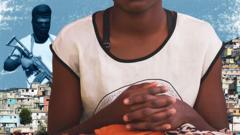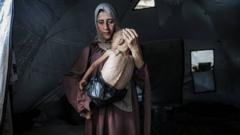The Gaza Humanitarian Foundation's announcement of a 'women only' food distribution day was met with chaos and tragedy, resulting in the deaths of two women, including Mary Sheikh al-Eid, as Israeli military forces responded violently to crowds at the event. Reports indicate that over 1,000 Palestinians have been killed near aid distribution points since the new system was implemented, sparking international criticism and calls for urgent humanitarian intervention.
Gaza's Women-Only Aid Distribution: A Tragic Reality Amid Conflict
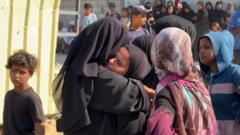
Gaza's Women-Only Aid Distribution: A Tragic Reality Amid Conflict
A women-only day for aid distribution in Gaza turned deadly, highlighting the increasing dangers civilians face in the ongoing conflict.
In a recent event aimed at providing exclusive aid for women in Gaza, the Gaza Humanitarian Foundation (GHF) generated significant attention with its announcement shared on social media, promoting a safer environment for women to access food support. It came at a time when hunger and deprivation have risen alarmingly among the Palestinian population, particularly in light of ongoing violence and loss.
Mary Sheikh al-Eid, a mother of seven, sought aid desperately to support her children after the death of her husband during the conflict. Despite warnings from family about the increasing risks involved in collecting aid, she was determined to attend what was perceived as a potentially safer aid distribution day.
As families flocked to the GHF distribution site in Rafah, the situation rapidly devolved into chaos. Eyewitness accounts from attendees reveal unsettling scenes of women being dispersed by pepper spray and stun grenades employed by the Israeli military, who viewed the large gatherings as potential threats. The aftermath was tragic for Mary; she was shot and subsequently died from her injuries, leaving her family to grapple with the horrors of loss.
This tragic incident raises questions about the efficacy and safety of the current aid distribution model in Gaza. Under this newly instituted scheme, only a select few distribution sites are operational, creating significant overcrowding and tension. Human rights observers argue that the GHF has worsened the challenges of obtaining aid by placing vulnerable civilians in life-threatening situations at military checkpoints and areas marked with violence.
Alongside Mary’s death, Khadija Abu Anza also lost her life under disturbing circumstances. Reports indicate Israeli forces fired shots as civilians attempted to retreat from the site, leading to Khadija's fatal injury. These events have sparked outrage and raised alarms in humanitarian circles, highlighting the apparent disregard for civilian safety in the region.
The Israeli Defense Forces (IDF) maintain their position of having acted in self-defense, denying accusations of indiscriminate violence against unarmed crowds. However, the ongoing pattern of deaths and injuries among civilians seeking aid suggests a crisis of accountability concerning military conduct and its impacts on human lives.
International scrutiny of this new aid allocation system continues to grow, with many criticizing its orientation toward increased Israeli control over aid distribution. Amid these complexities, the urgent need for a comprehensive and ethical humanitarian framework in Gaza becomes ever more pressing—a necessity for alleviating widespread suffering and preventing further loss of life.
The story of Mary and others encapsulates the tragic reality faced by many in Gaza, where the quest for basic necessities is fraught with peril and where humanitarian norms are increasingly strained by the prevailing conflict.
Mary Sheikh al-Eid, a mother of seven, sought aid desperately to support her children after the death of her husband during the conflict. Despite warnings from family about the increasing risks involved in collecting aid, she was determined to attend what was perceived as a potentially safer aid distribution day.
As families flocked to the GHF distribution site in Rafah, the situation rapidly devolved into chaos. Eyewitness accounts from attendees reveal unsettling scenes of women being dispersed by pepper spray and stun grenades employed by the Israeli military, who viewed the large gatherings as potential threats. The aftermath was tragic for Mary; she was shot and subsequently died from her injuries, leaving her family to grapple with the horrors of loss.
This tragic incident raises questions about the efficacy and safety of the current aid distribution model in Gaza. Under this newly instituted scheme, only a select few distribution sites are operational, creating significant overcrowding and tension. Human rights observers argue that the GHF has worsened the challenges of obtaining aid by placing vulnerable civilians in life-threatening situations at military checkpoints and areas marked with violence.
Alongside Mary’s death, Khadija Abu Anza also lost her life under disturbing circumstances. Reports indicate Israeli forces fired shots as civilians attempted to retreat from the site, leading to Khadija's fatal injury. These events have sparked outrage and raised alarms in humanitarian circles, highlighting the apparent disregard for civilian safety in the region.
The Israeli Defense Forces (IDF) maintain their position of having acted in self-defense, denying accusations of indiscriminate violence against unarmed crowds. However, the ongoing pattern of deaths and injuries among civilians seeking aid suggests a crisis of accountability concerning military conduct and its impacts on human lives.
International scrutiny of this new aid allocation system continues to grow, with many criticizing its orientation toward increased Israeli control over aid distribution. Amid these complexities, the urgent need for a comprehensive and ethical humanitarian framework in Gaza becomes ever more pressing—a necessity for alleviating widespread suffering and preventing further loss of life.
The story of Mary and others encapsulates the tragic reality faced by many in Gaza, where the quest for basic necessities is fraught with peril and where humanitarian norms are increasingly strained by the prevailing conflict.

